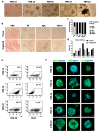Anti-Tumor Immunity to Patient-Derived Breast Cancer Cells by Vaccination with Interferon-Alpha-Conditioned Dendritic Cells (IFN-DC)
- PMID: 39340087
- PMCID: PMC11435915
- DOI: 10.3390/vaccines12091058
Anti-Tumor Immunity to Patient-Derived Breast Cancer Cells by Vaccination with Interferon-Alpha-Conditioned Dendritic Cells (IFN-DC)
Abstract
Background: Breast cancer represents one of the leading causes of death among women. Surgery can be effective, but once breast cancer has metastasized, it becomes extremely difficult to treat. Conventional therapies are associated with substantial toxicity and poor efficacy due to tumor heterogeneity, treatment resistance and disease relapse. Moreover, immune checkpoint blockade appears to offer limited benefit in breast cancer. The poor tumor immunogenicity and the immunosuppressive tumor microenvironment result in scarce T-cell infiltration, leading to a low response rate. Thus, there is considerable interest in the development of improved active immunotherapies capable of sensitizing a patient's immune system against tumor cells.
Methods: We evaluated the in vitro anti-tumor activity of a personalized vaccine based on dendritic cells generated in the presence of interferon (IFN)-α and granulocyte-macrophage colony-stimulating factor (IFN-DC) and loaded with an oxidized lysate from autologous tumor cells expanded as 3D organoid culture maintaining faithful tumor antigenic profiles.
Results: Our findings demonstrate that stimulation of breast cancer patients' lymphocytes with autologous IFN-DC led to efficient Th1-biased response and the generation in vitro of potent cytotoxic activity toward the patients' own tumor cells.
Conclusions: This approach can be potentially applied in association with checkpoint blockade and chemotherapy in the design of new combinatorial therapies for breast cancer.
Keywords: breast cancer; cancer vaccines; dendritic cells; immunotherapy.
Conflict of interest statement
The authors declare no conflicts of interest.
Figures






Similar articles
-
Engineered exosomes as an in situ DC-primed vaccine to boost antitumor immunity in breast cancer.Mol Cancer. 2022 Feb 11;21(1):45. doi: 10.1186/s12943-022-01515-x. Mol Cancer. 2022. PMID: 35148751 Free PMC article.
-
An autologous dendritic cell vaccine polarizes a Th-1 response which is tumoricidal to patient-derived breast cancer cells.Cancer Immunol Immunother. 2019 Jan;68(1):71-83. doi: 10.1007/s00262-018-2238-5. Epub 2018 Oct 3. Cancer Immunol Immunother. 2019. PMID: 30283982 Free PMC article.
-
Interferon-alpha (IFN-alpha)-conditioned DC preferentially stimulate type-1 and limit Treg-type in vitro T-cell responses from RCC patients.J Immunother. 2008 Apr;31(3):254-62. doi: 10.1097/CJI.0b013e318167b023. J Immunother. 2008. PMID: 18317362
-
Clinical trials of dendritic cell-based cancer vaccines in hematologic malignancies.Hum Vaccin Immunother. 2014;10(11):3125-31. doi: 10.4161/21645515.2014.982993. Hum Vaccin Immunother. 2014. PMID: 25625926 Free PMC article. Review.
-
Clinically feasible approaches to potentiating cancer cell-based immunotherapies.Hum Vaccin Immunother. 2015;11(4):851-69. doi: 10.1080/21645515.2015.1009814. Hum Vaccin Immunother. 2015. PMID: 25933181 Free PMC article. Review.
Cited by
-
Promising future of breast cancer vaccine asking for multidisciplinary collaboration: a literature review.Front Cell Dev Biol. 2025 Apr 24;13:1578883. doi: 10.3389/fcell.2025.1578883. eCollection 2025. Front Cell Dev Biol. 2025. PMID: 40342927 Free PMC article. Review.
References
-
- Yang J., Ju J., Guo L., Ji B., Shi S., Yang Z., Gao S., Yuan X., Tian G., Liang Y., et al. Prediction of HER2-positive breast cancer recurrence and metastasis risk from histopathological images and clinical information via multimodal deep learning. Comput. Struct. Biotechnol. J. 2022;20:333–342. doi: 10.1016/j.csbj.2021.12.028. - DOI - PMC - PubMed
-
- Locy H., Verhulst S., Cools W., Waelput W., Brock S., Cras L., Schiettecatte A., Jonckheere J., van Grunsven L.A., Vanhoeij M., et al. Assessing Tumor-Infiltrating Lymphocytes in Breast Cancer: A Proposal for Combining Immunohistochemistry and Gene Expression Analysis to Refine Scoring. Front. Immunol. 2022;13:794175. doi: 10.3389/fimmu.2022.794175. - DOI - PMC - PubMed
-
- Garaud S., Buisseret L., Solinas C., Gu-Trantien C., De Wind A., Van Den Eynden G., Naveaux C., Lodewyckx J.N., Boisson A., Duvillier H., et al. Tumor-infiltrating B cells signal functional humoral immune responses in breast cancer. JCI Insight. 2019;4:e129641. doi: 10.1172/jci.insight.129641. - DOI - PMC - PubMed
Grants and funding
LinkOut - more resources
Full Text Sources

